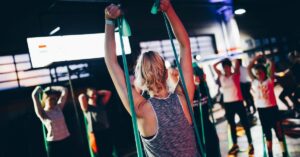The Hidden Benefits of Recovery Techniques You’ve Never Tried Before

The Hidden Benefits of Recovery Techniques You’ve Never Tried Before
In the relentless pursuit of athletic excellence, recovery is often an afterthought—a mere pit stop rather than a vital part of the journey. Most athletes know the usual suspects: ice baths, foam rolling, and perhaps the occasional massage. But what if I told you that there are recovery techniques lurking in the shadows, waiting to be unearthed and integrated into your routine? Techniques that can not only enhance your recovery but also elevate your performance to heights you never thought possible? Buckle up, dear reader, because we’re about to dive deep into the hidden treasures of recovery that you’ve probably never tried before.
Understanding Recovery: More Than Just Rest
Recovery is often misunderstood. Many believe that it’s simply about resting after a grueling workout or a tough match. In reality, recovery is a multifaceted process that involves physical, mental, and even emotional aspects. It struck me that many athletes overlook the importance of mental recovery—an equally crucial component that can significantly impact performance. After all, how often have you felt physically fine but mentally drained before a competition? You’re not alone.
Research indicates that athletes who incorporate varied recovery techniques can experience improvements not only in their physical state but also in their mental resilience. This is where our hidden techniques come into play. Let’s explore some lesser-known recovery strategies that could make a world of difference.
1. Contrast Water Therapy: A Refreshing Twist
Let’s start with contrast water therapy—sounds fancy, right? It actually involves alternating between hot and cold water immersion. Now, I remember the first time I tried this technique after a particularly grueling marathon training session. I felt like a human yo-yo, bouncing between hot and cold, but the results were undeniably impressive.
This method is believed to improve circulation and reduce muscle soreness. A study published in the Journal of Athletic Training suggests that athletes who regularly use contrast baths report lower levels of muscle soreness and faster recovery times. The hot water dilates blood vessels, increasing blood flow, while cold water constricts them, flushing out waste products. It’s like giving your muscles a mini spa treatment!
2. Breathing Techniques: The Power of Breath
Breathing techniques might seem too simple to be effective, but hear me out! Controlled breathing can significantly reduce stress levels and enhance recovery. I once attended a yoga class where the instructor emphasized the power of breathwork; it was an eye-opening experience. Not only did my muscles feel more relaxed, but my mind was also clearer than it had been in weeks.
Techniques like diaphragmatic breathing or the 4-7-8 method can lower cortisol levels (the stress hormone) and promote a state of calm. Research from the International Journal of Yoga suggests that incorporating these techniques into your post-workout routine can enhance recovery and improve sleep quality. And let’s face it, who doesn’t need a little extra help in the sleep department?
3. Active Release Technique (ART): Unlocking Tight Muscles
Ah, the infamous knots in our muscles—those pesky little reminders of a hard workout. Enter the Active Release Technique, or ART. This method involves a hands-on approach where a trained therapist applies pressure to specific areas while you move your muscles through different ranges of motion. It might sound a bit intimidating, but it’s like sending your tight muscles on a well-deserved vacation.
Many athletes swear by ART for its ability to release tension and improve mobility. I once had a session with an ART specialist after suffering from a tight IT band. The results were nothing short of miraculous. I felt as if I could finally run freely again! Research shows that ART can significantly reduce pain and improve function, making it a worthy addition to any recovery regimen.
4. Sound Therapy: Tune Into Recovery
Now, here’s a technique that might raise a few eyebrows: sound therapy. Yes, you heard that right! Utilizing sound frequencies to promote healing is gaining traction among athletes. Who would have thought that listening to soothing sounds could aid recovery? But studies suggest that sound therapy can reduce anxiety, lower heart rates, and even improve sleep quality—essential components for recovery.
During a particularly stressful training block, I discovered binaural beats—auditory illusions created by playing two slightly different frequencies in each ear. The result? A profound sense of relaxation. Research published in Neuroscience Letters shows that listening to these frequencies can lead to reduced muscle tension and increased overall well-being. So, next time you’re winding down after a workout, consider turning on some calming tunes.
5. Cryotherapy: Chill Out for Recovery
Let’s talk about cryotherapy—a technique that has taken the sports world by storm. Stepping into a chamber of sub-zero temperatures might sound like a scene from a sci-fi movie, but the benefits are real. Athletes often rave about cryotherapy for its ability to reduce inflammation and speed up recovery times.
In my experience, the first time I tried cryotherapy, I felt like I was stepping into an Arctic expedition. It was freezing, sure, but the post-session euphoria was worth it. Some studies have shown that cryotherapy can decrease muscle soreness and help with recovery after intense training sessions. Just be prepared for the inevitable “I-can’t-feel-my-fingers” moment!
6. Guided Visualization: Seeing is Believing
Here’s a technique that might not have crossed your mind: guided visualization. This practice involves imagining yourself succeeding—whether it’s running a personal best or executing the perfect play. It sounds a bit touchy-feely, but there’s science behind it. Research published in the Journal of Sports Sciences has shown that mental imagery can significantly enhance performance and recovery.
I remember trying this technique before a big race. I closed my eyes and visualized every step of the course, from the starting line to crossing the finish. The sheer confidence it instilled was palpable. Athletes who use visualization often report feeling more focused and less anxious before competitions, making it a powerful tool for recovery. Who knew that your mind could be such a potent ally?
7. Nutritional Recovery: Fueling the Body Right
When it comes to recovery, nutrition is a game-changer. While most of us know the importance of protein post-workout, there are other nutritional strategies that often fly under the radar. For example, incorporating anti-inflammatory foods like turmeric, ginger, and leafy greens can accelerate recovery. A colorful plate isn’t just for aesthetics—it’s a pathway to recovery!
During a particularly rigorous training cycle, I focused on my nutrition and began adding a green smoothie packed with spinach, avocado, and chia seeds to my post-workout routine. Let me tell you, the difference was remarkable! Studies indicate that diets rich in antioxidants and omega-3 fatty acids can reduce muscle soreness and inflammation. Think of it as nourishing your body from the inside out.
8. Nature Therapy: Mother Nature Knows Best
Sometimes, the best recovery isn’t found in a gym or a clinic but in the great outdoors. Nature therapy, or ecotherapy, involves spending time in natural settings to improve mental and physical well-being. This idea resonates deeply with me; there’s something incredibly refreshing about a hike in the woods or a stroll along the beach after a week of intense training.
Research suggests that spending time in nature can reduce stress, lower blood pressure, and improve mood. I recall a weekend camping trip I took after a particularly grueling race season. I returned feeling rejuvenated, as if the forest had wiped my mental slate clean. Incorporating nature therapy into your recovery routine might just be the reset you didn’t know you needed.
9. Laughter Yoga: Giggles and Gains
Yes, you read that right—laughter yoga! Merging laughter with traditional yoga poses, this technique is a delightful way to boost your mood while enhancing recovery. It may sound a bit silly (and trust me, it can be), but laughter releases endorphins, which can reduce pain and promote a sense of well-being.
One day, I stumbled into a laughter yoga class, unsure of what to expect. I ended up laughing so hard that I nearly fell over! The joy I felt afterward was palpable. Studies have shown that laughter can improve cardiovascular health and reduce stress, both crucial for recovery. So why not add a little laughter to your recovery routine? It’s like a free dose of happiness!
10. Journaling: Penning Down Your Thoughts
Lastly, let’s talk about journaling—a technique that might seem mundane but can be incredibly powerful for recovery. Writing down your thoughts, feelings, and training experiences can have therapeutic effects. It’s a chance to reflect on your journey, celebrate your achievements, and process any setbacks.
I started journaling after a tough competition season, and the clarity it brought was transformative. Research suggests that expressive writing can improve mental health and enhance overall well-being. By penning down my experiences, I could better understand my emotions, leading to more effective recovery. Plus, it’s a great way to keep track of your progress and set new goals.
Putting It All Together: A Holistic Approach to Recovery
As we’ve explored these hidden recovery techniques, it’s clear that the path to optimal performance involves more than just physical rest. Integrating a variety of recovery methods—be it contrast baths, sound therapy, or laughter yoga—can create a holistic approach to recovery. Think of it as building a toolbox; each technique contributes a valuable tool for your recovery journey.
While some of these techniques may resonate more than others, the key is to experiment and find what works best for you. Remember, recovery is a personal journey, and what works for one athlete might not work for another. The beauty lies in the exploration and discovery of your unique recovery rhythm.
Final Thoughts: Embrace the Unexpected
In the world of sports, we often chase the latest trends, training regimens, and nutrition fads. However, it’s essential to remember that some of the most profound benefits can come from the unexpected. As you venture into these hidden recovery techniques, keep an open mind and embrace the journey.
So, what are you waiting for? Dive into the world of contrast baths, sound therapy, or even laughter yoga. You might just discover a new favorite recovery routine that not only enhances your performance but also adds a little spark to your athletic journey. After all, recovery isn’t just about bouncing back—it’s about bouncing forward.
Let’s unlock those hidden benefits together!







